Editor of this issue: Violeta Kelertas, Univ. of Illinois at Chicago
Copyright © 1990 LITUANUS Foundation, Inc.

|
LITUANUS
LITHUANIAN QUARTERLY JOURNAL OF ARTS AND SCIENCES
Volume 37,
No.2 - Summer 1991
Editor of this issue: Violeta Kelertas, Univ. of Illinois at Chicago ISSN 0024-5089
Copyright © 1990 LITUANUS Foundation, Inc. |

|
THE ART OF AKVILA ZAVIŠAITĖ
ALGIMANTAS KEZYS
Akvilė Zavišaitė* was born in 1962 in Vilnius, Lithuania to the family of an architect and a journalist. Since childhood Akvila manifested signs of artistic talent. But when after graduating from high school she was denied admission to the Vilnius Art Institute for not being a member of the Komsomol, she enrolled in the Pedagogical Institute of Vilnius to study English and in 1983 she left Lithuania to join her mother in Australia. Here Zavišaitė studied art at the Newcastle College of Advanced Education graduating with a Bachelor's degree in the visual arts. In 1988 she completed her post-graduate studies at the Hunter Institute of Higher Education in Newcastle with a graduate diploma in art.
In her paintings and drawings Zavišaitė strives to put into perspective the experiences of her own life (especially as a night club dancer) and those of her family and friends. Her portraits of people possess what her critic and mentor Frank Celtlan called "almost intimidating presence."
Even as a child she was encouraged by her father (he was a brilliant architect) to draw. "I would go with my pad and watercolors," she wrote in her diary, "and sit on the shore [drawing landscapes]... I was even more interested in sneaking into the bars with him and watching all the people drinking and laughing with each other and with the charming barmaids."
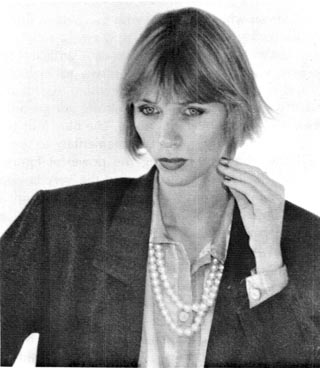
Akvila Zavišaitė, whose portfolio is presented in this issue, died June 2, 1991 in Sidney, Australia. She was a promising young Lithuanian artist whose loss will be deeply felt by all.
The pictures reproduced here are from her recent portfolio. The following descriptions of the paintings are taken from her diary:
CENTAUR. "This is the largest drawing I have yet done (250 x 120 cm) and the task I set myself was to use only pastels no paints at all and to use a horizontal streaking technique for shading some aspects of the picture contrasting with 'rubbing' in other aspects in order to present different textures within the work. The drawing is done on canvas which I washed with black paint first giving me a dark background on which to draw. Pastels 'bounce,' or stand out with more effect on the dark surface than on a white one, and the dark surface serves to highlight the forms and shapes. This drawing is entitled "Centaur" and depicts a woman so dynamic and strong yet graceful that she reminds me of a beautiful horse. The blue lounge chair is vibrating in the dark and is complementary to the colors of the body, thus emphasizing the powerful figure. The colors from the top of the picture to the very bottom are changing gradually: from warm pink to purples and violets and blues and the change continues on into dark green tones. The chair behind repeats the flow of the body opening out from the center; the curved outlines of the chair and the gathered curtains together with a similar gradation of colors behind the figure all lend emphasis to the curvy lines of the woman's body. The long, flowing hair becomes the energy released from the tensed and stretching body providing visually a juxtaposition of straight and soft with tense and curvy. I chose to draw this figure because I wanted to depict gracefulness and I liked this particular pose for an expression of gracefulness."
QUEEN OF CLUBS. " 'Queen of Clubs' depicts three ladies playing cards and sipping wine. This picture was actually my first big pencil drawing and involved much research. I wanted figures to look graceful, well-shaped with certain expressions on their faces so I spent lots of time sketching different parts of the body, using anatomy books. All the drawing is done on a rough surface paper using a simple pencil and some black oil-crayon. The picture is slightly distorted by the prolonged, curled up lines and the exaggerated shapes emphasize the characters and it gave me pleasure to play with the expressions."
THE BELEVUE HOTEL. Drawing portraits of bar people was Zavišaitė's means of expressing the reality of part of her life which she spent as a night club dancer. In order to supplement her student allowance she took a job at a sailors' tavern in the midst of Newcastle which employed dancing girls. It was convenient for her because during the days she could study, relax in the afternoons and then go to work at night. "I loved it all these shiny, silky, little costumes and wigs, wild dancing, long hours sitting at the bar and sipping vodkas during the breaks, all these loud people and girls kicking their legs and swinging their skirts. All of this reminded me of Toulouse-Lautrec's lifestyle. I was very fond of his works, but I also thought of him as clever and outrageous... During breaks in my dancing, I would often sketch people in the beer-garden. They were simple people and shy in a way, but they would all want to be drawn..."
DISTORTED IMAGES. The technique Zavišaitė liked to use and experiment with was that of distorted perspective. "Best of all I liked drawing with charcoal and I also liked experimental drawing using distorting mirrors. The latter especially absorbed me, and, since at this time I wanted to do only distorted images, I did a few self-portraits looking at my reflection in a glass, in an iron, spoons and so on... I loved the twisted images of the background and the whole composition of shapes seen in the iron."
RED DRESS. " 'Red Dress' was a picture of a girl standing lonely at the bar. It was a distorted figure, in a twisted pose, with exaggerated shoulders, hand, elongated arms, legs and waist. I felt I wanted to draw a distorted figure because the twist creates a certain mood, a feeling. It emphasizes what I want to say in the picture, i.e., long thin figure gives an impression of loneliness, maybe even of hunger and exhaustion... I especially love the effect of red on the black background... During these times I produced a few images from my imagination just to enjoy the shapes and lines, enjoy shading with the pencils and making some parts decorative. I could not avoid making the red dress hanging on the line entitled 'Spring Girl.' "
GIRL AND HER BELONGINGS. "My relationship with my boyfriend had just broken up. I was very distressed, packing my things, sorting them out, yet not knowing where to go. There was a mess both in the room and in my head. After two days of indecision, I was sitting on a box and drinking red wine with a friend who was trying to cheer me up, and also trying to talk me into becoming his steady girl-friend. I felt totally confused! While chatting with him, I made some sketches of my surroundings, actually putting myself in among my things... The objects depicted in 'Girl and Her Belongings' are ones that are important to me, e.g., my guitar, a book, my toy, make-up, bottle (corner showing), a bong fallen upside down, a man's silhouette in the background, myself sitting 'in question/ a confused expression on my face."
LOST GIRL. After returning from the trip to the United States Zavišaitė made an image of a girl standing alone in a deserted, dark and dreary street and named it "Lost Girl." In her diary she wrote: "The picture represents how I saw America. Besides the huge museums and galleries, homes like castles, big, expensive cars and great wealth apparent, there were also plenty of dark, narrow streets with poor shabby houses... I stayed with a girl-friend in one of these Mexican-Spanish suburbs in Chicago. The first two floors of her building were 'dead' walls peeling, pipes hanging out like monsters dark and cold and full of screeching cats. And here she is, standing alone in this crooked street, not knowing which way to go. The picture is a metaphor for many in the United States of America... In the process of making this picture I changed its shape. As can be seen, the top of the canvas is much wider than the bottom. Whilst in the midst of creating the image, I realized that the composition was wrong. I tore off the material from the board and felt free to re-form the shape of the canvas. This form was most pleasing to my eyes. The girl is standing under the street light, one shoe off, and the pavement corner so exaggerated as to emphasize the confusion. The largest part of the canvas is a black street to show emptiness and loneliness with no other vital soul present. There is the black shadow of the girl and then her glowing body in the red dress symbolizing something burning with life, eager to search, to live, to bloom!"
THE TRYPTYCH. "The previous picture 'Lost Girl' inspired me to produce more images of these dancing girls and also I had many sketches of the ladies I met in the tavern. The idea was to make three odd-frame shapes for the drawings which could be viewed together as in one picture or separately. I built up the story to match my 'Lost Girl' which had to be the last panel. The middle panel presents the dancing girls in their dressing-room fixing their hair and nails, resting, waiting for the show to start. There are colorful clothes hanging in the right corner, the black girl's reflection in a mirror, make-up on the cupboard as well as a bottle. The first panel depicts a 'Stripping Girl' on the stage... The stage lights are shining on the body, so I used lots of different colors, e.g., blue, brown, reds, purples, on the body and hair. Navy flags can be seen hanging above the colorful stage and the bar in the background. The body and the stage floor are done by streaking with numerous pastel colors. The lines which form the curtains and ceiling, the bar and the lights, and even the floor are all forming a tapestry. They are crisscrossed and create the energy while the body is smooth and soft yet the yellow lingerie-covered torso becomes the center of impact where the dynamic lines meet like waves then ripple back. After I had finished this Triptych, I realised that I have formulated a certain style. I knew what and how I wanted to draw in the future."
THE FUTURE. "My plan for the future is to develop and push my pastel technique further. I would like to complete more really large or long pastel drawings, to train myself completely with this particular technique, and subject matter female figures. I believe that some kind of animal/human creature is forming in my imagination. I would like to combine my other hobbies like astrology, the mysteries of the psyche, even perhaps palmistry, with my Art. These preoccupations are already becoming the subject matter or are at least having an inspirational effect on my Art."
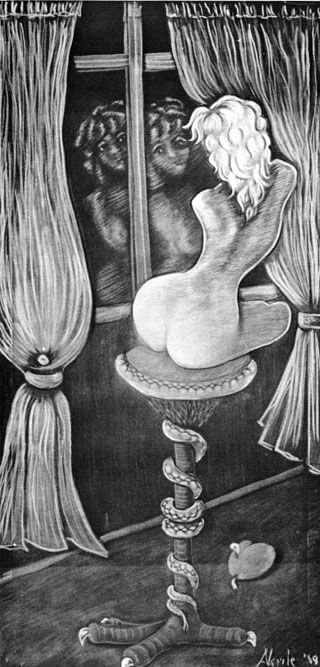
Akvila Zavišaitė, "Solitude," 1989; pastel on canvas, 160x80 cm.
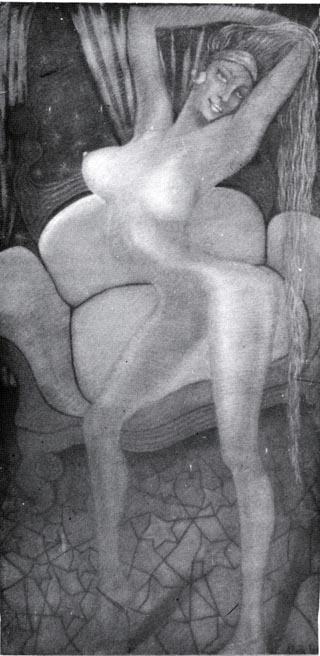
Akvila Zavišaitė, "Centaur," 1987; pastel on canvas, 250x125 cm.
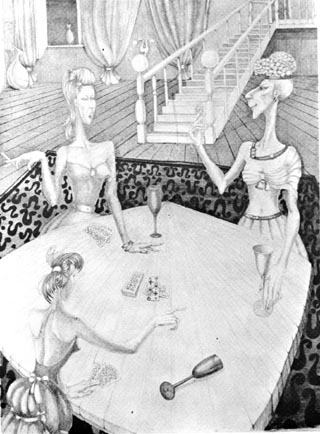
Akvila Zavišaitė, "Queen of Clubs," 1987, pencil on paper, 150x90 cm.
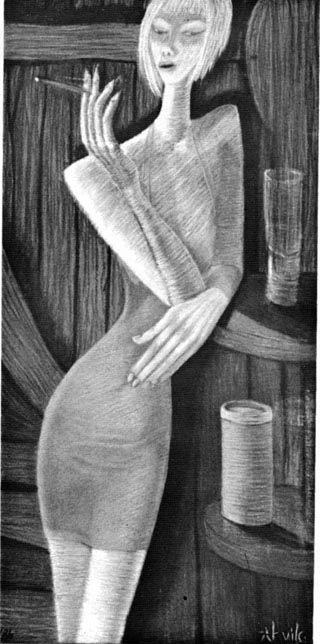
Akvila Zavišaitė, "Red Dress," 1987, pastels on canvas, 145x70 cm.
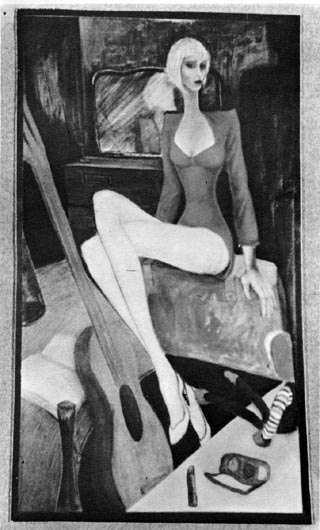
Akvila Zavišaitė, "Girl and her Belongings," 1987, pastels on canvas, 780x90 cm.
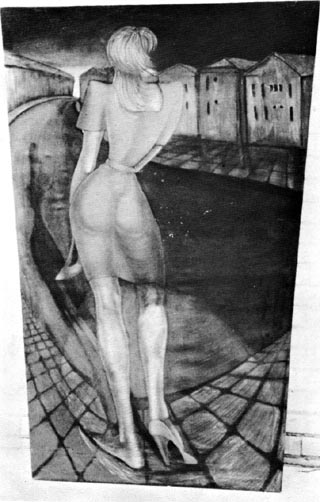
Akvila Zavišaitė, "Lost Girl," 1987, pastels on canvas, 185x125x90 cm.
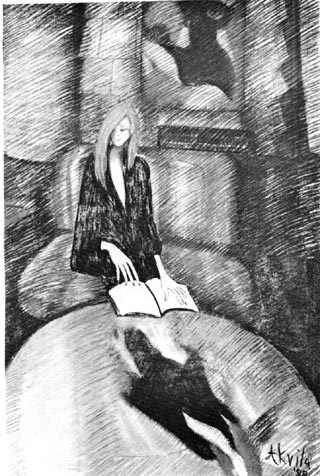
Akvila Zavišaitė, "Redhead," 1988, charcoal, pastels on paper
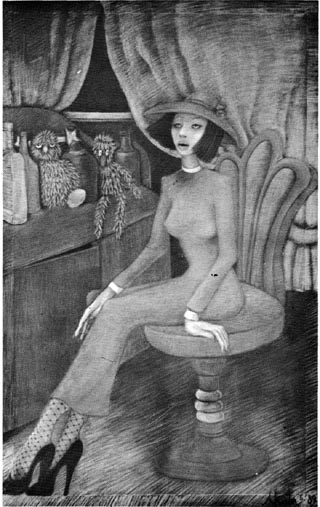
Akvila Zavišaitė, "Private Moment," 1989, pastels on canvas, 150x100 cm.
* Zavišaitė's art works were exhibited June 21-July 4, 1991 at the Lithuanian Art Gallery Čiurlionis, 5620 South Claremont Ave., Chicago, IL.